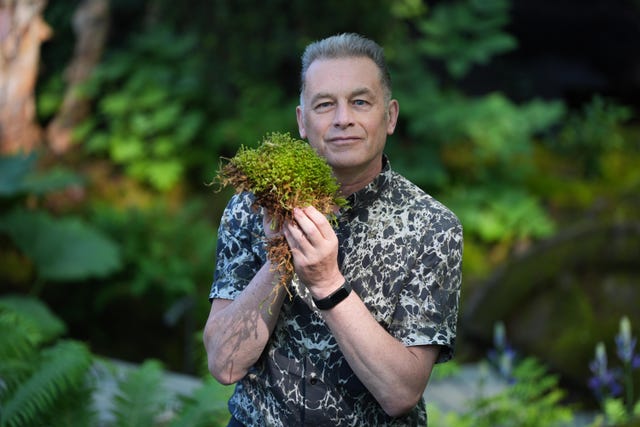Drought-resistant plants, green innovation and flood storage feature at Chelsea
The world famous flower show is also hosting a seedling from the felled Sycamore Gap tree, placed on the National Trust garden by Dame Judi Dench.

The Chelsea Flower Show is looking to a future with climate change, with gardens filled with drought-resilient plants, water storage and green innovation.
With the Royal Horticultural Society (RHS), which runs the show, introducing a “green audit” for larger gardens and handing out an environmental innovation award for the first time, this year’s show has a focus on sustainability.
And as celebrities get a first glimpse of the world famous show before the King and Queen tour the event on Monday, Dame Judi Dench was on hand to place a seedling from the Sycamore Gap tree, felled in an act of vandalism, onto the National Trust’s Octavia Hill garden.
The seedling, grown from a seed taken from the tree which had stood for 200 years in a dip on Hadrian’s Wall and named by Dame Judi as Antoninus after the adopted son of Emperor Hadrian, will be on display during the show.
Andrew Jasper, director of gardens and parklands at the National Trust, said he hoped visitors would take inspiration from seeing the seedling, saying: “When we first saw the seedlings germinate, we knew there was hope for the tree’s future.”
Ann-Marie Powell, who designed the Octavia Hill garden by Blue Diamond with the National Trust, said it was important to be establishing – not just planting – trees in gardens and urban areas to reduce heat, create moist shade and provide clean air.
Those needed to include non-native varieties, she said.
“We need to be using trees and plants that are going to be here in 20 years when London is as hot as Barcelona, otherwise what’s the point, all these trees will be dead and so will the wildlife they support.”

Ms Powell, who has had to adapt her plants for the garden in the face of this year’s weather which affected the growing season and has chosen resilient plants, said: “It’s climate change, and we are having to react to be able to grow plants not just for our benefit, but for our beloved garden wildlife.
“It’s happening really fast. I’m noticing it year on year now, and I think a lot of us even as pros are winging it a bit so and I think it is a time of massive experimentation.”
At this year’s show, the RHS has awarded its first environmental innovation award to a garden which uses 3D printed terracotta blocks that fit together like Lego to make planters inspired by Sub-Saharan African keyhole gardens, which are moisture-retentive, sustainable planters for crops.
The garden for World Child Cancer UK was designed thinking not only of the final result, but also the process, and was constructed onsite at the Royal Hospital Chelsea with no power tools, according to designer Giulio Giorgi.
The 3D blocks require no concrete or chemical glue, were fired using clean electricity, can be reused and rebuilt, and will go to RHS Wisley after the show to be part of a children’s learning project, while the plants are drought-resilient.
Mr Giorgi told the PA news agency: “We really need to work our technologies and also garden strategies to cope with climate change, to cope with more humble resources.
“For me, the message is with simple means, you can still do something beautiful.”
RHS head of sustainability Malcolm Anderson said the garden was “a beautifully humble, clever garden”.
He said the award had been introduced because the judging process at Chelsea did not pick up sustainability.

“What we wanted to do really is, because we’re seeing more and more designers and contractors really pushing the boundaries of what is built, to reward innovation for innovation’s sake,” even if it failed in terms of producing a top show garden, he said.
Mr Anderson said choosing a winner from the 11 gardens that entered was a really hard decision, as so much work had been done by every single one, adding: “We’ve moved the dial, and we’ve moved it in a year.”
He suggested gardeners were waking up to the need for sustainability, and the charity had been pushing the issue – but in a positive way.
Many of the gardens at this year’s show are filled with drought-resilient and wildlife-friendly planting, tips for storing water, championing of trees, and naturalistic looks including wetland meadows, mossy dells and traditional country garden and meadow flowers.
A garden from flood insurance scheme Flood Re, which rains every 16 minutes raising the water levels in the garden, highlights how backyards can be made more flood resilient, in the face of one in eight gardens flooding this year.
A tank collecting runoff in the garden stores 10 bath tubs of water – the amount of rain that can fall on a house in a downpour – while the sunken garden takes 100 bath tubs.
This means it can help reduce the risk of homes flooding, while flood-resilient plants have been planted in the lowest parts of the garden and less water-loving blooms are higher up.
Flood Re’s Harriet Boughton said: “It’s beautiful, but also purposeful.”





